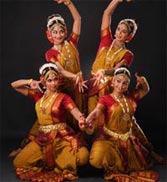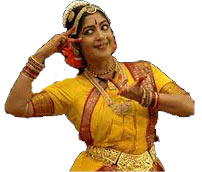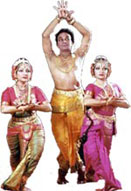KUCHIPUDI
Origin
Kuchipudi dance form in India originated from a hamlet in Andhra Pradesh, called Kuchelapuri or Kuchelapuram, in the 3rd century B.C. Kuchipudi like many other classical dance forms was initially presented at temples and was performed by the Brahmin men who were called as Bhagavathalu. Such dances were meant to prove as offerings to the deities and in this women were never allowed to participate in the dance group. In the year 1502 AD the very first group of Brahmin performers called Bhagavathalu was formed.Kuchipudi was initially introduced as a dance drama, but its present day dispensation tells a different story altogether. Today it has reduced only to dance form, with the drama missing completely. With proficient training and knowledge dancers of Kuchipudi have started presenting the dance form in their individualistic concepts. In todays generation the majority of the Kuchipudi dancers are women. Kuchipudi dramas are enacted during nights in open air on improvised stages. The audience generally sit on the ground.
Steps involved in the dance
 Kuchipudi is performed on the classical Carnatic music. The instruments used for recital includes the Mridangam, Flute and Violin. The lyrics of the dance are sung by a vocalist and the organization of the music and recital of the rhythmic patterns are done by the "Nattuvanar". Kuchipudi the south Indian dance form is a perfect amalgamation of "Nritta", "Nritya" and "Natya". The Nritta consists of a song; the Nritya or "Sabdams" consitutes the interpretation of the song through dance and Natya combines both into a complete dance drama having a storyline and characters along with elements of both.
Kuchipudi is performed on the classical Carnatic music. The instruments used for recital includes the Mridangam, Flute and Violin. The lyrics of the dance are sung by a vocalist and the organization of the music and recital of the rhythmic patterns are done by the "Nattuvanar". Kuchipudi the south Indian dance form is a perfect amalgamation of "Nritta", "Nritya" and "Natya". The Nritta consists of a song; the Nritya or "Sabdams" consitutes the interpretation of the song through dance and Natya combines both into a complete dance drama having a storyline and characters along with elements of both.The Kuchipudi uses a lot of fast rhythmic foot movements with the graceful sculpture like body movements are the highlights of this dance form. The dance even consists of mime, hand gestures and subtle facial expression. Another feature of Kuchipudi is "Tarangam" where the dancer dances on the edge of a brass plate according to the rhythm of music and some times dancers also balance a pot of water on the head.
Rituals Before Kuchipudi
 Before starting the dance of Kuchipudi, there are certain rituals that are performed in front of the audience.
Later after the rituals the Soothradhara or the conductor, with the supporting musicians, comes on stage, gives a play of rhythm on the drums and cymbals and announces the title of the dance drama. After this two people enter holding a curtain, behind which is a dancer in the mask of Ganpati the elephant headed god. The dancer dances for some time, to worship Ganpati, so that the dance drama goes on without hitches.
Before starting the dance of Kuchipudi, there are certain rituals that are performed in front of the audience.
Later after the rituals the Soothradhara or the conductor, with the supporting musicians, comes on stage, gives a play of rhythm on the drums and cymbals and announces the title of the dance drama. After this two people enter holding a curtain, behind which is a dancer in the mask of Ganpati the elephant headed god. The dancer dances for some time, to worship Ganpati, so that the dance drama goes on without hitches.Introduction of Characters
In a Kuchipudi dance performance, each principal character introduces himself or herself on the stage with a daru. A daru is a small composition of dance and song specially designed for each character, they reveal his/her identity and also to show his/her skill in the art. There can be as many as 80 darus or dance sequences in a Kuchipudi performance. All of them help set the mood of the drama as well as the characters in it. Thereafter, the performance finally begins.Make-up, Costumes and Music
Make-up and costumes are the unique characteristics for dance form of Kuchipudi. Apart from the make-up, the female characters also wear ornaments and jewelry, such as Rakudi (head ornament), Chandra Vanki (arm ornament), Adda Bhasa and Kasina Sara (neck ornament), and a long plait decorated with flowers and jewelry. Most of the ornaments worn by the artists are made of a light weight wood, called Boorugu.
Most of the ornaments worn by the artists are made of a light weight wood, called Boorugu.In todays world Kuchipudi is considerably a different style of dance form than it originally used to be. In most of the cases it is now a solo performance dance done by female dancers. The Sutradhara has become a phenomenon of the past and the Vachika abhinaya, that is, expressional numbers are sung by the danseuses herself instead by the vocalists in the background on the stage as was the traditional practice.
The element of devotion to gods has also been done away with and it has become purely a secular affair with predominance of 'sringar' or erotic flavour. Besides the drama component has also been totally reduced. The major number is from Jaideva's Ashtapadi, the Ramayana, the Puranas, Tirtha Narayana's Krishna Lila Tarangini or Tyagaraja's compositions, but now the dancer combines into herself the roles of the singer who sings the 'daruvu', the actor who speaks the lines and the dancer who mimes and dances to interpret the text. Elements not indigenous to the dance drama such as sculpture like stances and freezes based on perfect iconographic forms motifs and shapes have also been incorporated into Kuchipudi dance recitals to make it more competitive with other dance forms.
Popular dancers
Shri. Raja and Smt. Radha Reddy are the most extraordinary Kuchipudi dancers and they have been bestowed with number of awards which includes "Padma Bhushan" the highest award to honor a performing artist by the Government of India. Dr. Vempati Chinna Satyam,Guru Jayarama Rao and Vanashree Rao Vedantam Lakshminarayana, Dr. Uma Rama Rao, Tadepalli Perayya, Chinta Krishna Murthy are some of the prominent personalities of Kuchipudi. Kuchipudi has gripped its roots in forgien countries also like Nilimma Devi, Sasikala Penumarthi and Revathi Komanduri in Atlanta, Kamala Reddy in Pittsburgh, Ratna Papa in Texas, Jyothi Lakkaraju, Vaidehi Yellai, Himabindu Challa, and Madhuri Kishore in San Francisco.
Dr. Vempati Chinna Satyam,Guru Jayarama Rao and Vanashree Rao Vedantam Lakshminarayana, Dr. Uma Rama Rao, Tadepalli Perayya, Chinta Krishna Murthy are some of the prominent personalities of Kuchipudi. Kuchipudi has gripped its roots in forgien countries also like Nilimma Devi, Sasikala Penumarthi and Revathi Komanduri in Atlanta, Kamala Reddy in Pittsburgh, Ratna Papa in Texas, Jyothi Lakkaraju, Vaidehi Yellai, Himabindu Challa, and Madhuri Kishore in San Francisco.
Learning Kuchipudi
Kuchipudi Dance AcademyC/o Vijaya Prasad
42, Dayananad Society Gopal Nagar Rd-1
Dombivli(E) 421201 Maharashtra, India
Phone:91-251-2448093 Email: [email protected]


